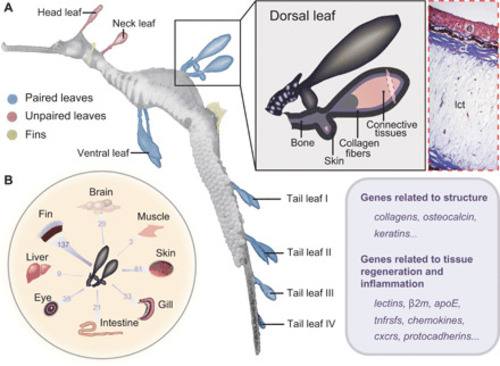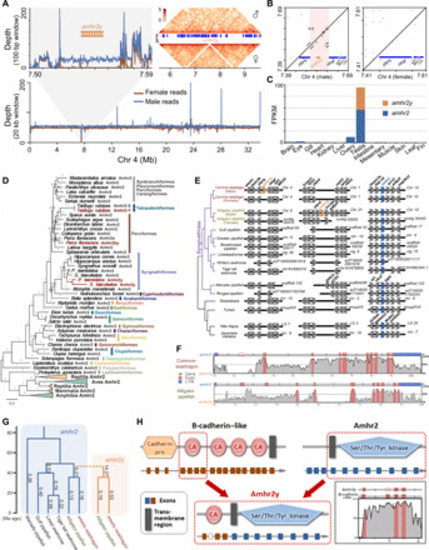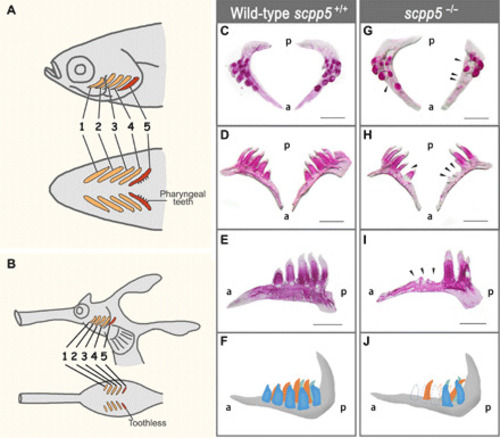- Title
-
Seadragon genome analysis provides insights into its phenotype and sex determination locus
- Authors
- Qu, M., Liu, Y., Zhang, Y., Wan, S., Ravi, V., Qin, G., Jiang, H., Wang, X., Zhang, H., Zhang, B., Gao, Z., Huysseune, A., Zhang, Z., Zhang, H., Chen, Z., Yu, H., Wu, Y., Tang, L., Li, C., Zhong, J., Ma, L., Wang, F., Zheng, H., Yin, J., Witten, P.E., Meyer, A., Venkatesh, B., Lin, Q.
- Source
- Full text @ Sci Adv
|
Key features of the common seadragon (P. taeniolatus) and the alligator pipefish (S. biaculeatus) and their phylogenetic positions.
(A) The common seadragon has a dragon-shaped body with many special leaf-like appendages and long tubular snout lacking teeth. Common seadragon males incubate eggs on a brood patch on the underside of the tail. (B) A male alligator pipefish showing eggs incubated on a brood patch on the underside of trunk. (C) Phylogenetic tree of 19 ray-finned fishes. Bootstrap values below 80 are not shown. |
|
Morphology and genetic makeup of the leaf-like appendages in the common seadragon (P. taeniolatus).
(A) Location and structure of leaf-like appendages. The inset on the right shows a zoomed in schematic of the leaf-like appendages along with its transverse section. Genes expressed in the leaf-like appendages that are related to structure, tissue regeneration, and inflammatory response have been listed in the box below. e, epidermis; cf., collagen fiber; lct, loose connective tissues. (B) The number of genes recruited from other tissues for the maintenance of leaf-like appendages. |
|
Putative sex determination gene in the common seadragon (P. taeniolatus) and the alligator pipefish (S. biaculeatus).
(A) Characterization of a Y-specific region in the common seadragon. Illumina data illustrating the relative read depth across a region of Chr4, in males (blue line) and females (red line) showing a coverage difference between the two; the Hi-C data heatmap of the Y-specific region showing the male-specific region, with half of the average read-coverage; gene annotation indicates only one gene (amhr2y, represented in orange). (B) Repetitive sequences present in the Y-specific region of the male genome but not in the female. (C) Tissue-specific expression of amhr2y and amhr2 in the common seadragon. (D) Phylogenetic tree of amhr2 amino acid sequences in vertebrates. The Y-specific amhr2 (red) originated independently in pufferfish (T. rubripes), yellow perch (P. flavescens), and the common ancestor of common seadragon (P. taeniolatus) and alligator pipefish (S. biaculeatus). (E) Synteny analysis of amhr2y and amhr2 loci in the common seadragon, alligator pipefish, and other teleosts. (F) Identity plot of the alignment of amhr2y gene with the autosomal amhr2 gene sequence in the common seadragon and alligator pipefish. (G) The duplication event of amhr2y is shown as a dashed line in the phylogenetic tree. Clades of amhr2 and amhr2y are in blue and orange, respectively. The ω values are shown at the right of each branch. (H) Schematic depiction of the events leading to the formation of the alligator pipefish amhr2y gene, which is likely to be the result of fusion between B-cadherin–like and amhr2 genes. |
|
Pharyngeal tooth phenotypes in zebrafish scpp5 homozygous mutants.
(A) Schematic diagram showing the teeth located on the fifth gill arch in zebrafish. (B) Schematic diagram showing five pairs of toothless pharyngeal arches in the common seadragon. (C to J) Comparison of number and distribution of pharyngeal teeth in mutant (scpp5−/−; G, H, and I) versus wild-type (scpp5+/+) fish (C, D, and E). Eleven of 24 (45.8%) F3 homozygous scpp5−/− individuals exhibit a marked reduction in the number of teeth related to a failure of tooth replacement (G, H, and I, black arrowheads). (F and J) Schematic representations of the tooth phenotype of scpp5+/+ and scpp5−/− fish, respectively (ventral tooth row, blue; medio-dorsal tooth row, orange; dorsal tooth row, green; and the dotted lines indicate missing tooth structures). Scale bars, 0.5 mm; a, anterior; p, posterior. PHENOTYPE:
|




